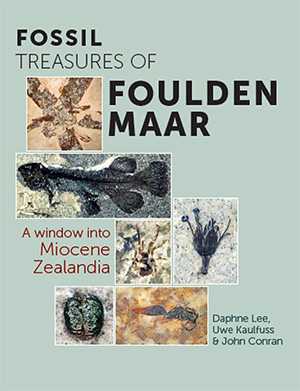Next week, the School of Biological Sciences at the University of Adelaide is hosting the Australian launch of a new publication on of New Zealand’s best known (and controversial) fossil localities, co-authored by State Herbarium Research Affiliate Dr John Conran (The University of Adelaide).
 D.E. Lee, U. Kaulfuss & J. Conran (2022). Fossil treasures of Foulden Maar: A window into Miocene Zealandia. (Otago University Press: Dunedin, NZ).
D.E. Lee, U. Kaulfuss & J. Conran (2022). Fossil treasures of Foulden Maar: A window into Miocene Zealandia. (Otago University Press: Dunedin, NZ).
Foulden Maar in Otago, New Zealand, a now infilled former lake, is home to an amazing record of life on Earth and is a paleontological site of international significance. Formed by a violent one-off volcanic eruption 23 million years ago, it comprises tens of thousands of undisturbed annual layers that record the changing life and ecosystems in and around a small, deep volcanic crater lake that existed for more than 130,000 years at the very beginning of the Miocene. The site is unsurpassed in the Southern Hemisphere.
Fossils in Foulden Maar include abundant plant remains, represented by leaves (including two rare fossil orchids), fragile flowers with pollen (including the world’s only fossil Fuchsia), fruits, seeds, wood and bark, together with pollen grains, fern, moss and fungal spores and billions of diatoms.
Animal fossils from the freshwater lake and surrounding rainforest abound and include the oldest known galaxiid (whitebait) fish on Earth, the first freshwater eel found in the Southern Hemisphere, sponges and myriad insects and spiders, virtually all new to science. Fish larvae still have their patterned skin, insects their eyes, antennae and wing patterns and some have retained their colour.
Ecological interactions are also captured: scale insects may be seen in life position on leaves, fish have the remains of their last meal in their stomach, and insect damage on plants is common. Evidence for waterbirds on the lake is seen in the abundance of fossilised sandy coprolites in the diatomite layers.
Most remarkable of all, Foulden Maar preserves a record of the climate fluctuations, year by year, through the life of the lake. Detailed analyses of core samples taken from the diatomite deposit have revealed temperatures, rainfall, global climate cycles (including ENSO cycles) and changing carbon dioxide (CO2) levels in a world 23 million years ago.
This unparalleled archive of past life and climate shows that the mean annual temperature in the area was 8°C warmer than today – a marginally subtropical climate. The increased temperature was connected to higher CO2 levels of 450 parts per million (ppm) – approaching those that Earth will reach in the next few decades.

Example fossils from Foulden Maar: (A) A Fouldenia flower with preserved pollen; (B) Metrosideros (rātā) fruit; (C) galaxiid (whitebait) fish larva; (D) chrysomelid (leaf beetle) wing cases with colour still preserved; (E) a winged male Myrmecorhynchus ant. Photos: J. Conran & U Kaulfuss.
The authors are:
- Daphne Lee (University of Otago), who has been a coordinator of the research team at Foulden Maar since 2003 and in 2017, Daphne received the McKay Hammer from the Geoscience Society of New Zealand, the premier award for geological research in New Zealand. She is currently an Honorary Associate Professor in the Geology Department.
- Uwe Kaulfuss (University of Göttingen, Germany) completed his PhD focusing on the sedimentology and palaeontology of Foulden Maar and received the Harold Wellman Prize in 2009 for the discovery of fossil insects at Foulden Maar. Uwe continues to work on the biogeography and evolution of New Zealand fossil insects, funded by the German Research Foundation.
- John Conran (The University of Adelaide) is a botanist and paleobotanist who joined the Foulden Maar research group in 2006. He has co-supervised several University of Otago and University of Adelaide Honours and postgraduate student projects on aspects of the Foulden Maar biota and is still working on the flora and palaeoecology of the site.
- The foreword was written by Paul Selden, palaeontologist and arachnologist and Gulf-Hedberg Distinguished Professor Emeritus at the University of Kansas.
The book is available officially from the NZ distributors, Nationwide Books, as well as John Reed in Australia.
Compiled by Research Affiliate John Conran.


